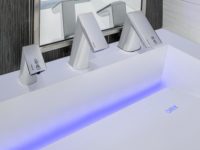As recently as four years ago, the specification rate for automatic sensor faucets in commercial applications was close to 28%.
Fast forward to today and that number has doubled to nearly 60%.
Sensor faucets were originally invented to address the “yuck” factor — where no one wanted to touch faucets in public bathrooms. They have since evolved to deliver superior water-saving benefits and elegant aesthetics for modern Class A facilities. New finish options such as brushed stainless or matte black provide architects and designers with more options to bring their vision to life.
Within the past year, automatic sensor faucets have evolved to become one of the most useful sources of data in the commercial restroom environment. Facility managers and maintenance personnel looking to save time and money are always on the lookout for accurate data to manage their preventative maintenance plan. They are now getting it in real-time on smartphones.
Engineers who used to have to install temporary metering equipment to gain insights into water usage and system balance now have accurate metering built into individual faucets. Public health and regulatory officials now have ways to ensure there is automatic flushing of water lines before they become stagnant, bringing fresh disinfectant residual into former “dead legs.”
All of this exciting new functionality will keep automatic sensor faucets on the fast track for even higher spec rates in commercial facilities because these are advantages that manual faucets cannot deliver.
Data delivers
Time is money for commercial building managers. They are often deploying thin resources to “put out fires” rather than keeping up with reoccurring maintenance as much as they would like. Thus, any tool that helps avoid unanticipated emergencies, interruptions to operations and customer complaints is welcomed. If that tool also makes preventative maintenance quicker and easier, it’s appreciated. If the tool can help turn a preventative maintenance routine into a predictive maintenance routine, it’s the best possible outcome for a facility manager. The time that used to be spent on unplanned emergencies can become time spent on other more pressing issues across the facility.
About 96% of facility management and maintenance personnel carry a smartphone with them at their work location. Commercial sensor faucet manufacturers are now utilizing smartphone technology to wirelessly access below-deck faucet controls and adjust settings, eliminating the need to close off the facilities to the public, take apart sink enclosures and spend the time required to crawl under the sink. Since there is a Bluetooth transmitter in every faucet, real-time data is available for facility managers to engage in predictive maintenance. Restroom upkeep can then be calculated on a schedule according to usage, instead of making maintenance a guessing game.
With commercial faucets specified in sensitive locations such as airports, railyards, hospitals, laboratories and more, taking preventative cybersecurity measures is critical. In support of wireless technology, at least one manufacturer has taken advanced cybersecurity measures to guard against hackers. Sloan explains it ran its products through independent third-party cybersecurity testing to provide the peace of mind that intelligence yielded from faucets is secure. It has also abided by the best practices guidelines provided by the U.S. Department of Homeland Security - Science and Technology Directorate.
Some manufacturers have incorporated Amazon’s Alexa voice-controlled personal assistant technology into their sensor faucets. This is an example of a divergence in practicality for residential and consumer applications. While intriguing from a residential standpoint, voice-controlled technology is simply not practical for commercial products in an environment with multiple users using multiple faucets.
Shutting down stagnant water
As plumbing fittings continue to deliver reduced flow rates to meet sustainability and efficiency goals, the prominence and risk of stagnant water increases. This creates opportunities for undesired contamination issues as water loses its disinfection residual (i.e,. chlorine) over time, creating conditions for organism growth and proliferation.
Facility managers are starting to rely on sensor faucets to address this problem, as manual faucets aren’t equipped with the technology to do so. Automatic sensor faucets can now be programmed wirelessly to take the stagnant water that has been sitting in the line and flush it out, bringing in fresh residual on a regular, programmable and documented basis. This also provides new opportunities to save time and money — an automated method to document line flushing and elimination of the need to deploy personnel to flush lines manually.
For those with low-flow fittings contributing to increasingly frequent drain blockages from soap residue or a lack of water necessary to clear p-traps, sensor faucets can now be programmed on-site as needed to overcome these issues.
As automatic sensor faucets continue to deliver innovations beyond their traditional hygienic benefits, they are leading the way for other commercial restroom products to reinvent themselves, too. Everything from flush valves to soap dispensers could soon be placed onto a predictive maintenance model to help facility owners cut costs and increase efficiency while still pleasing customers.




